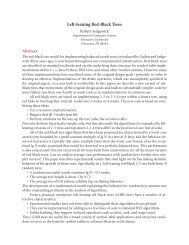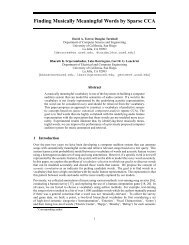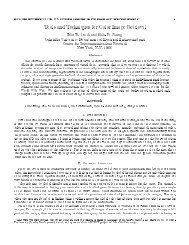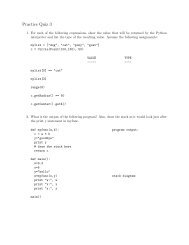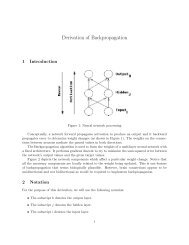Solving Geometric Problems with the Rotating Calipers *
Solving Geometric Problems with the Rotating Calipers *
Solving Geometric Problems with the Rotating Calipers *
Create successful ePaper yourself
Turn your PDF publications into a flip-book with our unique Google optimized e-Paper software.
p i+2<br />
p i+1<br />
θ i<br />
p j<br />
p i<br />
Fig. 1<br />
In this paper we show that this simple idea can be generalized in two ways: several sets of<br />
calipers can be used on one polygon or one pair of calipers can be used on several polygons. We<br />
<strong>the</strong>n show that <strong>the</strong>se generalizations provide simple O(n) solutions to a variety of geometrical<br />
problems defined on convex polygons. Such problems include <strong>the</strong> minimum-area enclosing rectangle,<br />
<strong>the</strong> maximum distance between sets, <strong>the</strong> vector sum of two convex polygons, merging convex<br />
polygons, and finding <strong>the</strong> critical support lines of linearly separable sets. The last problem, in<br />
turn, has applications to problems concerning visibility, collision avoidance, range fitting, linear<br />
separability, and computing <strong>the</strong> Grenander distance between sets.<br />
2. The Smallest-Area Enclosing Rectangle<br />
θ j<br />
p j+1<br />
p j+2<br />
This problem has received attention recently in <strong>the</strong> image processing literature and has applications<br />
in certain packing and optimal layout problems [2] as well as automatic tariffing in goodstraffic<br />
[3]. Freeman and Shapira [2] prove <strong>the</strong> following crucial <strong>the</strong>orem for solving this problem<br />
Theorem 2.1: The rectangle of minimum area enclosing a convex polygon has a side collinear<br />
<strong>with</strong> one of <strong>the</strong> edges of <strong>the</strong> polygon.<br />
The algorithm presented in [2] constructs a rectangle in O(n) time for each edge of P and selects<br />
<strong>the</strong> smallest of <strong>the</strong>se for a total running time of O(n 2 ).<br />
This problem can be solved in O(n) time using two pairs of calipers orthogonal to each o<strong>the</strong>r.<br />
Let L s (p i ) denote <strong>the</strong> directed line of support of <strong>the</strong> polygon at vertex p i such that P is to <strong>the</strong> right<br />
of <strong>the</strong> line. Let L(p i , p j ) denote <strong>the</strong> line through p i and p j . The first step consists of finding <strong>the</strong> vertices<br />
<strong>with</strong> <strong>the</strong> minimum and maximum x and y coordinates. Let <strong>the</strong>se vertices be denoted by p i , p k ,<br />
p l , and p j , respectively, and refer to Figure 2. We next construct L s (p j ) and L s (p l ) as <strong>the</strong> first set of<br />
calipers in <strong>the</strong> x direction, and L s (p i ), L s (p k ) as <strong>the</strong> second set of calipers in a direction orthogonal<br />
- 2 -<br />
p i<br />
θ i<br />
θ l<br />
p j<br />
p l<br />
θ j<br />
Fig. 2<br />
θ k<br />
p k



